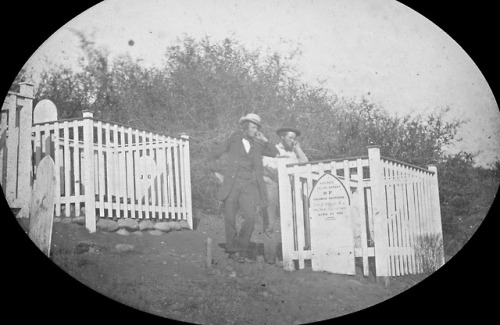#history of california
A collection of mugshots of people arrested for various crimes in San Francisco, California, in 1902.
Source: Sacramento Police Department.
Daguerreotype portrait of two men posing with the grave of Solomon Harthorn somewhere in California, c. 1853.
Source: Sotheby’s.
Post link
Exploring a strange new world, tales of the monstrous and the fabulous, as a type of story these are very old, enduring, and probably take shape across cultures (though I can only speak from my place in the West).
Recently seeing the Movie Oz(….), I was reminded of early European popular fiction, like the Sergas… in the minds of the Conquistadors (see here). This genre and specific set of tales, while notable in the history and naming of California, had previously reminded me of similar figures and tropes in literature preceding the Sergas well into antiquity (see the page tagged Warrior Queens on the side bar).
The tale of Calafia specifically made me recall the tales of Candace (or Kandake) from the Alexander Romances, a genre of tales written continuously in each succeeding age since Alexanders conquests in the 300’s BCE–presumably originating in the recounts of those original soldiers but over the years transforming into the truly fantastic.
The Armenians had preserved a large body these tales (as I am told by The Greek Alexander Romance as translated by Richard Stoneman (penguin classics)). This is where I began seeing the long-scale connections, for the Armenians were subsumed by the Byzantine Empire around 1000 CE, and their diaspora their persisted until the Turkish conquest just before 1500 CE. Their stories and histories no doubt admixed with the Byzantines and when both groups went westward fleeing Ottoman rule, they inspired the revived classicism of the Renascence.
This revival would also inspire the popular press of the day, often over looked by history for their provincial literary merits and skewed renderings of actual events. But it is precisely these stories which inspired the explorers of that age, and perhaps their drive to observe the fantastic, or to marry an amazon or too.
My point in this is that the collection of tales gathered under the ‘Alexander Romances’ are an excellent lens to observe the continuous manifestation of these literary devices, psychological projections on a cultural scale: the self, the other, the strange, the fantastic. And how they very often play out in terms of gender and race (with very real world consequences).
It would be fruitful to study the similarities between the popular Spanish story that introduced the idea of California to the world in such a fantasy, with the recounts of the Alexander romances. Specifically descriptions of places outside the charted world, abundant in gold and jewels, where above normal sized warrior women rule, subject themselves to marring the outsiders, they use magical beasts in combat (in the romances they are sphinxes, in the Sergas they are griffons), and they are governed by a queen who shares a hereditary position and name (in the Sergas its Calafia, in the romances is Candace).
such passages as:
’ Know ye that at the right hand of the Indies there is an island called California, very close to that part of the Terrestrial Paradise, which was inhabited by black women without a single man among them, and they lived in the manner of Amazons. They were robust of body with strong passionate hearts and great virtue. ’ [Sergas de Esplandian, via the wiki commons]
are remarkably similar to those in the romances, where Alexanders army, marching into the unknown world finds lands and islands of resplendent bounty and:
“here dwell the Amazons, who are larger than other races of women and remarkable for their beauty and strength. …They wear silver weapons and axes… they are notable for their intelligence and quick wits”
[the Greek Alexander Romances, Stoneman 146].
**the Silver weapons are similar to the Golden ones the Sergas describes (like the similarity and discrepancy of griffons/sphinxes previously mentioned)

